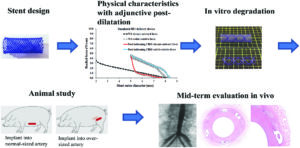Biodegradable stents (BDSs) have proven to be better compared to permanently implanted metallic stents for the treatment of endovascular diseases in children. Currently, BDSs that are made out of polylactic acid (PLA) with degradation times of 2–3 years are not suitable for infants, where the ideal healing time for an artery is 3 to 6 months. Poly p-dioxanone (PPDO) is an ideal alternative owing to its availability, FDA approval in clinics and suitable degradation time of 6 months. But, braided PPDO fiber stents still have lower stiffness than standard self-expanding metal ones.
Researchers from China have come up with a novel design strategy to reinforce the mechanical properties of PPDO fibers by using an elastomeric polycaprolactone (PCL) coating which can serve as a binder at to improve the compression performance. This self-expandable, fiber-based, composite braided biodegradable stent (CBBS) made of PPDO and PCL was then assessed for its physical properties, changes in mechanical properties during degradation, etc and compared with the control, cobalt–chromium-based alloy self-expanding stents (WALLSTENTs/WSs). CBBSs delivered in sheaths post dilation exhibited similar mechanical properties as WSs.
In vitro degradation studies showed that CBBSs post-dilation retained effective mechanical support and stent weight (almost 90%) for at least 16 weeks, which is adequate for arterial healing. These results corroborate with the hydrolysis mechanisms involved in degradation of PDDO, the main component and with in vivo histopathological evaluation.
Lastly, the stents were implanted in porcine models without resulting in any evidence of complications such as implant migration, thrombosis, dissection or aneurism. The mechanical performance of CBBS was also not worse than metallic stents in vivo. Angiographic analysis revealed vessel stenosis and an inflammatory response (intima proliferation) at 4 months due to hydrolysis induced degradation of the stent. But this inflammation was resolved at 12 months due to the complete degradation of CBBSs unlike the WSs. When different diameters of WSs were compared, the ones in oversized common iliac arteries exhibited higher luminal gain initially but there was stenosis and vascular injury compared to normal-sized abdominal aortas in the mid-term follow-up period
All the results combined demonstrate the advantages of these novel composite braided degradable stents over the standard metallic ones in terms of mechanical strength and appropriate degradation rate.
To find out more please read:
Jing Sun, Kun Sun, Kai Bai, Sun Chen, Fan Zhao, Fujun Wang, Nanchao Honga and Hanbo Hu
Biomaterials Science, 2020, DOI: 10.1039/d0bm00567c
About the web writer:
 Saswat Choudhury is a graduate student at the Indian Institute of Science Bangalore pursuing research on biomaterials and tissue engineering. He studies bioabsorbable polymers, design and characterization for biomedical applications. Besides research, he is also interested in science communication. You can find him on Twitter @saswatchoudhur1
Saswat Choudhury is a graduate student at the Indian Institute of Science Bangalore pursuing research on biomaterials and tissue engineering. He studies bioabsorbable polymers, design and characterization for biomedical applications. Besides research, he is also interested in science communication. You can find him on Twitter @saswatchoudhur1











